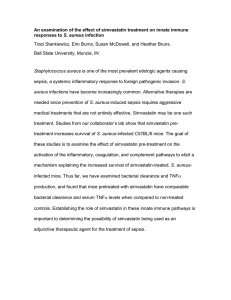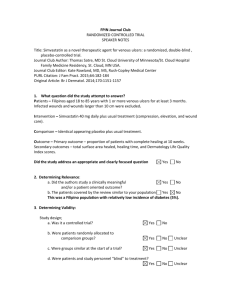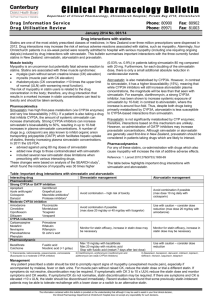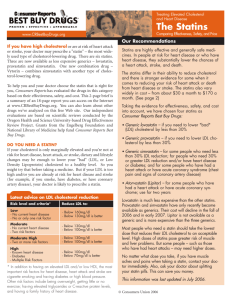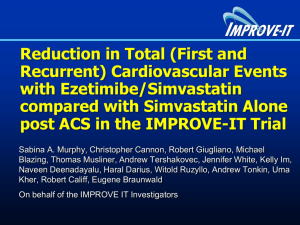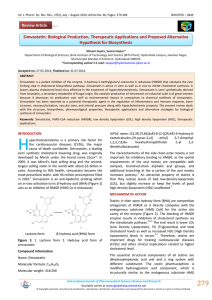Green Chemistry Case Studies: Presidential Green Chemistry
advertisement
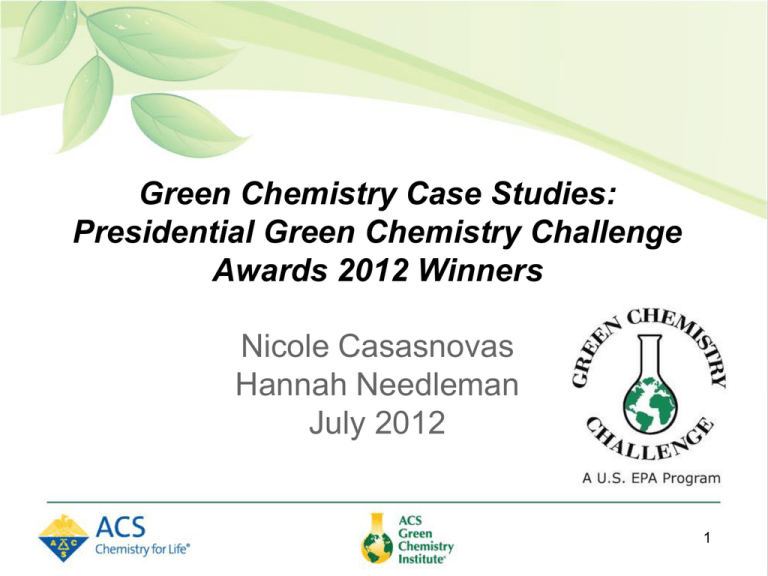
Green Chemistry Case Studies: Presidential Green Chemistry Challenge Awards 2012 Winners Nicole Casasnovas Hannah Needleman July 2012 1 Case 2: Codexis, Inc. & Dr. Yi Tang, UCLA Winner in the Area of Greener Synthetic Pathways 2 Overview Title: An Efficient Biocatalytic Process to Manufacture Simvastatin Summary: Simvastatin, a leading drug for treating high cholesterol, is manufactured from a natural product. The traditional multistep synthesis was wasteful and used large amounts of hazardous reagents. Professor Tang conceived a synthesis using an engineered enzyme and a practical low-cost feedstock. Codexis optimized both the enzyme and the chemical process. The resulting process greatly reduces hazard and waste, is cost-effective and meets the needs of customers. Some manufacturers in Europe and India use this process to make simvastatin. 3 Codexis Receiving EPA Presidential Green Chemistry Challenge Award Photo Credit: Peter Cutts Photography 4 Motivation Business Drivers • • Simvastatin was originally developed by Merck under the brand name Zocor® as a cholesterol lowering drug o In 2005, Zocor® was Merck’s best selling drug and the second-largest selling statin in the world with about $5 billion in sales o In 2006, Zocor® went off patent and simvastatin became the mostprescribed statin in the world Why was it important to spend resources developing this technology? o Simvastatin is one of the most important drugs on the market for treating cardiovascular diseases o In 2010, there were over 94 million prescriptions for Simvastatin o Codexis saw a great opportunity to reduce cost and waste to environment by reducing complexity of manufacturing process 5 Motivation Innovations in Science and Engineering • • • Simvastatin is a derivative of lovastatin, a fungal natural product, and contains an additional methyl group at the C2’ position of the side chain. This subtle structural modification makes simvastatin more potent in the reduction of total and low-density lipoprotein cholesterol (LDL-C) with decreased hepatoxicity and reduced side effects. Existing Technology o Two routes to manufacturing simvastatin: 1) Hydrolysis/Esterification ? 2) Direct Methylation o Disadvantages for both processes: • Low overall yields (<70%) Utilize excess hazardous and toxic reagents Require copious amounts of solvents Can we do better? Chemical structure of lovastatin (left) and its semi-synthetic derivative simvastatin (right) with additional methyl substituent (arrow). 6 Technology Development • • Approach: Design a green manufacturing process for simvastatin using biocatalysis while optimizing chemical process engineering. The UCLA team… o cloned and identified the LovD enzyme for biological synthesis of lovastatin, o demonstrated that LovD can be used to synthesize simvastatin, and o identified a simple acyl donor (DMB-SMMP) that could potentially support an economic, large-scale process. LovD acylase 7 Technology Development • Codexis… o recognized that this basic process could be improved via its CodeEvolver™ technologies and licensed the UCLA technology, o improved the enzyme as well as the process chemistry to enable a large scale simvastatin manufacturing process, o established commercialization path via Arch Pharmalabs and a second undisclosed partner, and o established biocatalyst manufacture at contract manufacturer. Natural + Biocatalyst Directed evolution = Optimized Biocatalyst 8 Business Activities • • • • Established commercialization path via Arch Pharmalabs and a second undisclosed partner Established biocatalyst manufacture at contract manufacturer Maintain long term relationships with several partner companies Partner companies come inbound seeking new technology and processes, which results in limited outbound marketing 9 Impact Environmental, Health, and Safety Benefits • • • • • • • Catalyst is produced efficiently from renewable feedstocks Reduced use of toxic and hazardous substances like tert-butyl dimethyl silane chloride, methyliodide, n-butyl lithium Improved energy efficiency as the reaction is run at ambient temperature and at near atmospheric pressure Reduction in solvent use due to the aqueous nature of the reaction conditions The only biproduct (methyl 3-mercaptopropionic acid) is recycled The major waste streams generated are biodegraded in biotreatment facilities Codexis’ process can produce simvastatin with yields of 97% o Significant when compared to <70% with other manufacturing routes 10 Impact Economic Benefits • • Customers have evaluated the simvastatin produced biocatalytically and confirmed that it meets their needs Total manufacturing costs are reduced by this new process o Less feedstock materials and solvents required o Less energy and water required during the o Aqueous and biodegradable waste streams 11 Thank You! • The following representative was integral in the creation of this report: o Wes Bolsen, Codexis, Inc.
